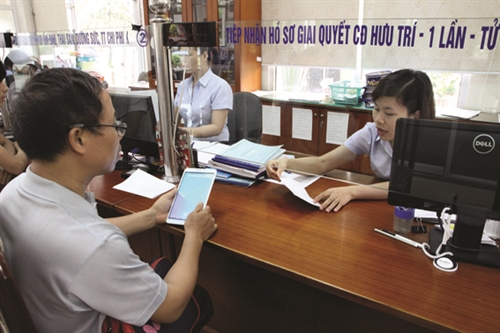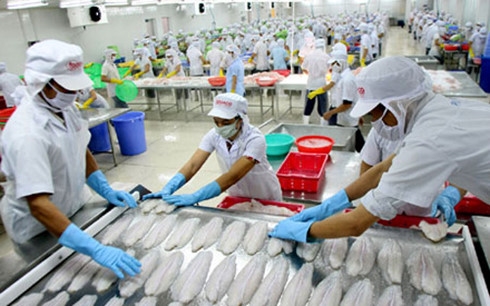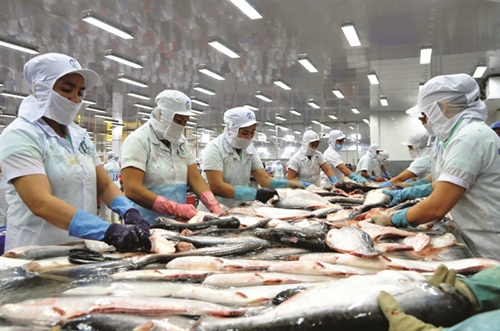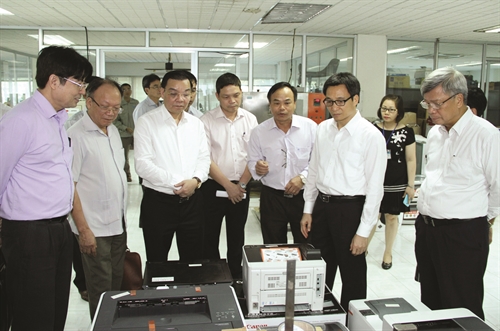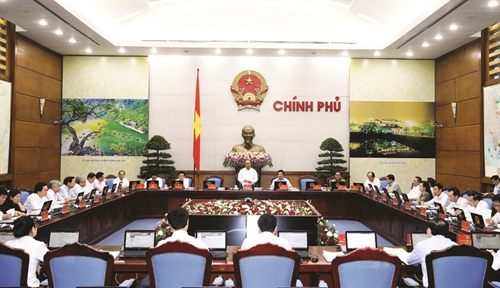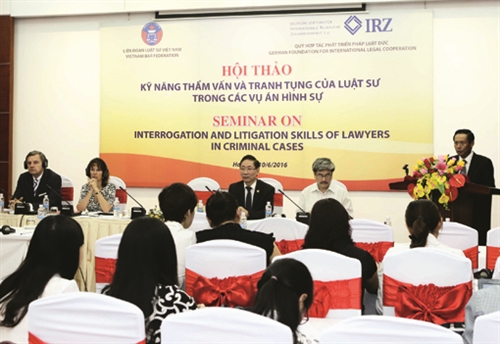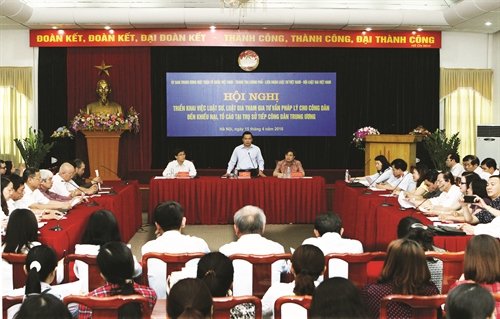Bui Duc Hien, LL.D
Institute of State and Law
Over the recent years, big and abnormal natural disasters, including typhoon, flood, flash flood, drought, whirlwind, etc., have appeared more frequently and complicatedly in Vietnam, causing unprecedented serious consequences.
Due to climate change, typhoons have occurred in orbits difficult to predict, which tend to move southward, causing heavy property and human losses for areas they have swept through, such as Chanchu and Maysak hurricanes which hit Central Vietnam. It is anticipated that strong hurricanes will increase in the future. Other natural phenomena such as flood, water logging, torrential rain, sea level rise, landslide, etc., have also happened more regularly in many localities, causing heavy damage to infrastructure and agricultural production.
Aside from the natural factors, those developments have been attributed also to such non-natural factors as forest destruction, irrational land use, unplanned construction and excessive exploitation of natural resources.
Current policies and legislation on disaster response
Vietnam’s viewpoints on natural disaster prevention and control as well as climate change monitoring have been concretized in different legal documents, such as the 1994 Ordinance on Exploitation and Protection of Hydro-meteorological Works (replaced by the 2015 Law on Meteorology); the 2001 Ordinance on Exploitation and Protection of Irrigation Works; the 2006 Law on Dikes; the 2012 Law on Water Resources; the 2013 Law on Natural Disaster Prevention and Control; the 2014 Law on Environmental Protection, and many sub-laws.
The 2013 Law on Natural Disaster Prevention and Control, which took effect on May 1, 2014, has institutionalized the line and policies of the Party and the State on natural disaster prevention and control, meeting the requirements on sustainable socio-economic development, environmental protection, defense and security maintenance and protection of national sovereignty and interests, and conforming to the current socio-economic conditions of the country as well as each locality. It has retained and codified the still appropriate provisions of the Ordinance on Storm and Flood Prevention and Control and relevant legal documents, while adding new provisions addressing practical issues, and incorporating a number of provisions of sub-law documents. According to the Law, natural disaster prevention and control cover prevention of natural disasters, response to natural disasters and remediation of their consequences.
The 2015 Law on Hydro-meteorology clearly regulates hydro-meteorological forecasts about natural disasters with provisions on compulsory hydro-meteorological observation of important projects greatly affecting the socio-economic development, and on hydro-meteorological forecasts and warnings.
A number of provisions of the 2013 Law on Natural Disaster Prevention and Control as well as regulations of the Government and Prime Minister also directly regulate hydro-meteorological forecasts and warnings.
Current policies and legislation on climate monitoring
The policies and legislation on response to climate change are addressed in the Party Central Committee’s Resolution No. 24-NQ/TW in 2013 on protection of environmental resources and response to climate change, and institutionalized in Article 63 of the 2013 Constitution. Furthermore, climate monitoring and climate change response are also dealt with in the 2014 Law on Environmental Protection in Article 4 and Chapter IV (Articles from 39 thru 48), stressing the management, assessment, monitoring and forecast of climate change impacts on socio-economic development, the environment and community health (Point a, Clause 1, Article 47). However, these provisions focus mainly on climate change response (adaptability and mitigation of climate change). There are few provisions on climate monitoring.
The 2015 Law on Hydro-meteorology, effective on July 1, 2016, is the first-ever law that regulates all hydro-meteorological activities in Vietnam, which creates a legal corridor for continued development of hydro-meteorological activities and facilitate the participation of the public in these activities.
The Law contains provisions on a national hydro-meteorological database, its information and data contents and the storage, exploitation and use of these information and data. It stipulates: “Products of hydro-meteorological activities shall be classified into two types: products serving the community and natural disaster prevention and control, which shall be provided free of charge and widely disseminated; and products serving exclusive demands, which are considered a commodity and may be only provided at a charge under current regulations” (Chapter 4). Climate change monitoring is addressed in Chapter 5 (Articles 33 thru 37) of the Law, with provisions on contents of climate change monitoring; a database on climate change monitoring; national climate evaluation; climate change scenarios; and inclusion of climate change monitoring results in strategies, master plans and plans. These provisions serve as an important base for the effective monitoring of climate change in Vietnam.
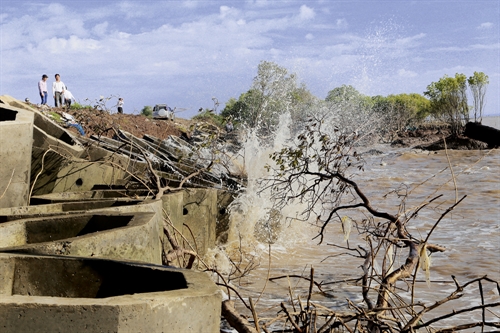 |
| Sea dike erosion in Go Cong Dong district, Tien Giang province, due to climate change__Photo: Nam Thai/VNA |
Practical implementation
With regard to natural disasters, response activities have been carried out at three levels: prevention; response; and remediation of consequences, with the close coordination among central and local agencies. This has helped minimize property and human losses despite frequent and abnormal natural disasters. Reality also shows that improvements have been seen in climate forecasts and warnings. For instance, people have been provided via the mass media, especially television, and free SMS with not only information on abnormal extreme phenomena but also concrete warnings as well as how to prevent and avoid them.
Climate monitoring has been assigned to the National Hydro-meteorology and Climate Change Center, which has been organizationally strengthened and equipped with modern climate observation stations (with a satellite - VN Red Sat 1 - already launched, and another - VN Red Sat 2 - is due to be launched), thus contributing to more effective climate monitoring. Vietnam has also joined the East Sea tsunami warning network, and stepped up international, regional and bilateral cooperation in this area.
However, there remain limitations and shortcomings in the natural disaster response and climate monitoring.
First, legal provisions on natural disaster prevention and control as well as climate monitoring are scattered and somehow inconsistent due to the lack of a persistent policy on disaster response and climate and climate change monitoring. For example, climate change response is defined in the 2014 Law on Environmental Protection while climate change monitoring is provided in the 2015 Law on Hydro-meteorology. Natural disaster response is prescribed in the 2013 Law on Natural Disaster Prevention and Control and the 2006 Law on Dikes, while monitoring activities are provided in the 2015 Law on Hydro-meteorology.
Second, the functions and tasks of natural disaster prevention and control and climate change monitoring organizations see overlaps with too many bodies involved in this process while their coordination remain weak. For example, the agency performing the state management of natural disaster and climate monitoring is the Hydro-meteorology and Climate Change Department while the body taking charge of natural disaster forecast and warning is the National Hydro-meteorology Center. The agency coordinating natural disaster prevention and control is the Central Steering Committee for Natural Disaster Prevention and Control, while the rescue is assigned to the National Committee for Search and Rescue. For the implementation of international commitments on climate change response, Vietnam has set up the Standing Office of the Steering Committee for implementation of the Framework Convention on Climate Change and Kyoto Protocol. The participation in this process by too many bodies has caused overlap and contradictions in competence and waste of human and financial resources, thus reducing performance results.
Third, Vietnam lacks accurate and timely natural disaster and climate change forecasting and warning systems, particularly for post-disaster warnings. For example, when an earthquake hit the northeastern region with vibrations reaching Hanoi, only few hours after the quake could we find reports about it on newspapers and television.
Fourth, the disaster forecasting and climate change monitoring networks, though recently upgraded, still issue inaccurate forecasts. Moreover, the poor coordination among agencies in responding to natural disasters and delays in overcoming their consequences have been the cause of heavy property and human losses in Vietnam.
Fifth, due to limited awareness of natural disaster prevention and control as well as climate monitoring, the supervision of these activities by competent authorities has proved ineffective.
Sixth, the funding sources for building facilities and training human resources for natural disaster prevention and control as well as climate change monitoring remain inadequate.
Seventh, although the policies and legislation on natural disaster prevention and control as well as climate change monitoring have been further improved in recent years, the qualifications and managerial capabilities of officials involved in this work remain limited.
Eighth, the natural disaster response and climate change monitoring technologies have not been upgraded in time to meet practical requirements.
Ninth, international cooperation on natural disaster response and climate change monitoring remains incommensurate to potential and practical requirements.
Perception and solutions
The formulation and improvement of policies and legislation on natural disaster response and climate change monitoring in the coming time should stick to the following view and solutions.
Vietnam needs to develop a policy and legal framework based on the perception that abnormal natural disasters and climate change are closely interrelated. This framework will serve as a foundation for the formulation and enforcement of the law on natural disaster response and climate monitoring.
The making of policies and legislation on natural disaster response and climate monitoring must conform to sustainable national development requirements. This work must take into due consideration the objectives of protecting human rights to live in a clean environment, to have their health and lives guaranteed and protected, to social security. Besides, it must draw on the strength of communities, civil societies and mass media for this issue.
Regarding solutions, the first one is to review the provisions on natural disaster response and climate monitoring in the Law on Environmental Protection, the Law on Natural Disaster Prevention and Control, the Law on Hydro-meteorology and relevant laws. Such a review should point out issues already specified, those still provided in a general manner, those not yet touched upon, and particularly those regulated by conflicting provisions, which need to be amended. In addition, Vietnam needs to issue more specific regulations on hydro-meteorological forecast and climate change monitoring, socialization of hydro-meteorological services and promotion of the participation of the private sector in climate change adaptation and reduction efforts.
Recent floods and torrential rains in Central Vietnam and droughts in the Mekong River Delta show that irrigation works, such as dikes, reservoirs, canals, and regulation lakes, have played an extremely crucial role in natural disaster prevention and control as well as climate change monitoring. Therefore, it is necessary to study the construction of large reservoirs in Central Vietnam and Central Highlands, where most rivers are short and sloping, unable to retain water, and the construction of some reservoirs in the Mekong River Delta where droughts hit more severely due to climate change. Seawater intrusion prevention systems also need to be built there. Some privately-owned small hydroelectric power plants prone to cause damage to people’s life and production should be nationalized, some of which should be turned into public reservoirs.
The third solution is to clearly define the functions, tasks and powers of the state bodies currently involved in the state management of natural disasters and climate monitoring as well as their coordination in the management and handling of natural disaster and climate change risks.
Currently, many natural disaster forecasts and warnings are still inaccurate. Upon occurrence of natural disasters, especially environmental incidents, the coordination among state management bodies remains problematic, leading to delays in the direction and implementation of natural disaster response and climate monitoring activities.
Natural disaster relief work in many localities remains ineffective. Therefore, another solution is to revise the current regulations on social relief for natural disaster victims to make this work swift and responsive to people’s essential needs in each circumstance and each stage of occurrence of disasters. A social relief law should be put into place. Particularly, it is necessary to strengthen the legal mechanism and raise the role of communities, social organizations and people to participate in assisting and supporting people in natural disaster-hit areas.
Funds for investment in building facilities and training human resources for natural disaster prevention and control as well as climate change monitoring are inadequate. So, besides the state budget, additional funds should be sought from international and other lawful sources.
Another solution is to raise public awareness and increase professional training for officers involved in natural disaster prevention and control as well as climate change monitoring.
Last but not least, greater investment should be poured into science and technology to serve natural disaster response and climate monitoring, such as procurement of modern weather forecasting radars and application of satellite-based technologies and disaster riskmanagement software.
Finally, Vietnam should increase international cooperation in natural disaster response and climate change monitoring, especially cooperation within the frameworks of international, regional and bilateral agreements such as WTO, Paris Agreement, European Union-Vietnam Free Trade Areas (EVFTA), and ASEAN. Besides, the country should boost bilateral cooperation with strategic partners strong in natural disaster response and climate monitoring. Such cooperation will help Vietnam integrate more deeply into the international community and make full use of financial, scientific and technological resources as well as managerial experiences to cope with disaster risks.-

